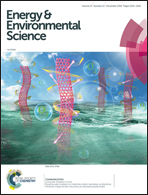Vapor-fumigation for record efficiency two-dimensional perovskite solar cells with superior stability†
Abstract
Two-dimensional (2D) perovskites have emerged as prospective candidates for high performance perovskite solar cells (PSCs) due to their remarkable environmental stability. However, their power conversion efficiency (PCE) is much lower than that of their 3D counterparts owing to large exciton binding energy, poor carrier transport, and low conductivity. Herein, we developed a methylammonium (MA) based 2D perovskite thin film using vapor-fumigation technology. Compared to the traditional 2D perovskite based on bulky butylammonium (BA) cations, its exciton binding energy significantly decreased to 172 meV from 510 meV, as calculated by first-order perturbation theory and an infinite barrier approximation, due to the high dielectric constant of MA. According to the WKb approximation, the tunneling probability of a carrier through a quantum well increased by four orders of magnitude because of the smaller layer thickness, which was confirmed by XRD (the layer spacing decreased to 9.08 Å of MA2PbI4 from 13.39 Å of BA2PbI4). In addition, theoretical calculations and experimental analysis reveal that the MA2PbI4 perovskite possesses a narrow band gap, good conductivity, and a low trap density. As a result, the PCE of the 2D PSCs reached 16.92%, and the certified efficiency was 16.6% according to the National Institute of Metrology (NIM), the highest efficiency value so far for 2D PSCs. Furthermore, the MA2PbI4 devices exhibited superior long-term stability under illumination and exposure to environmental conditions. The PCEs of the 2D perovskite devices without encapsulation degraded by only 2.2% from their initial values when exposed to ambient conditions at ∼55% relative humidity for 1512 hours. Meanwhile, the efficiency remained 97.2% of its initial value when the device was continuously illuminated for 500 hours at 60 °C in argon. Even after following the illumination test with light-soaking for over 500 h in ambient air, the PCE of the unsealed device suffered only a minor degradation of 3.8%.



 Please wait while we load your content...
Please wait while we load your content...